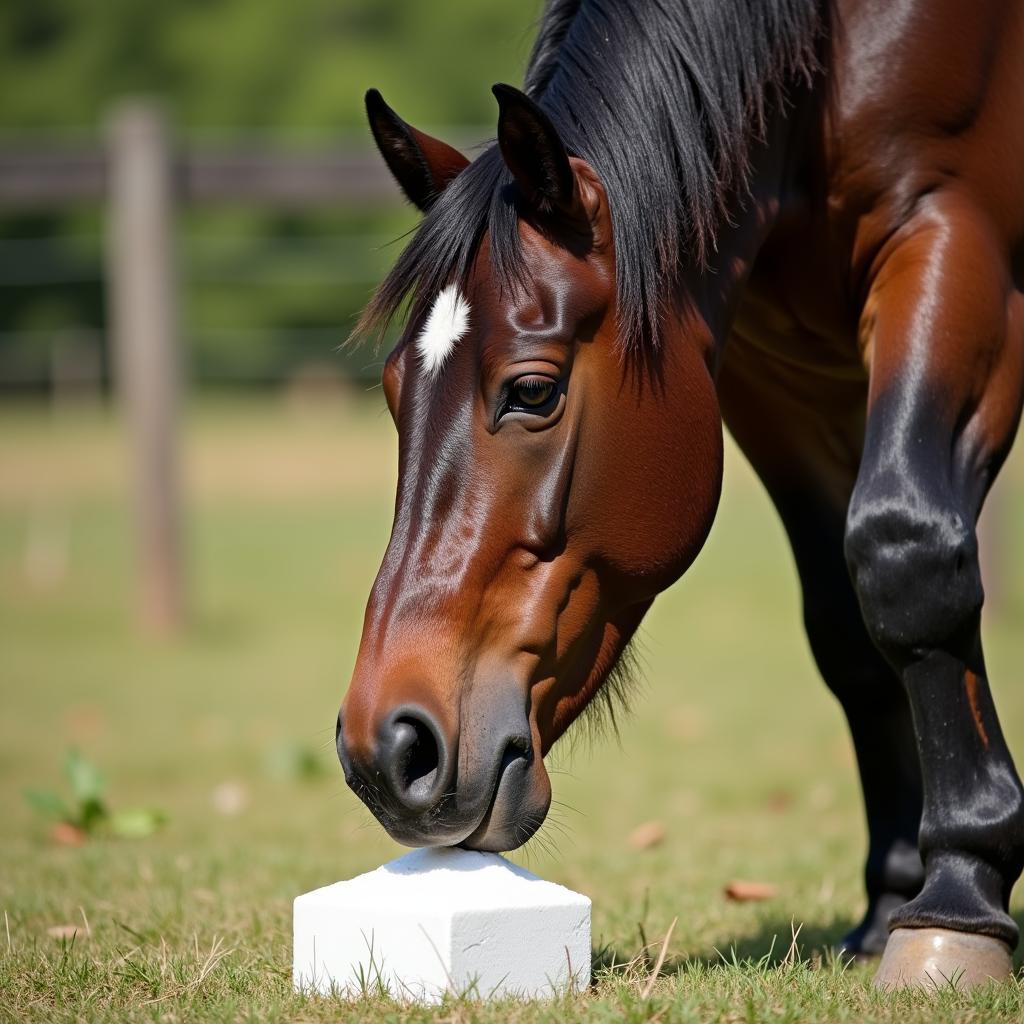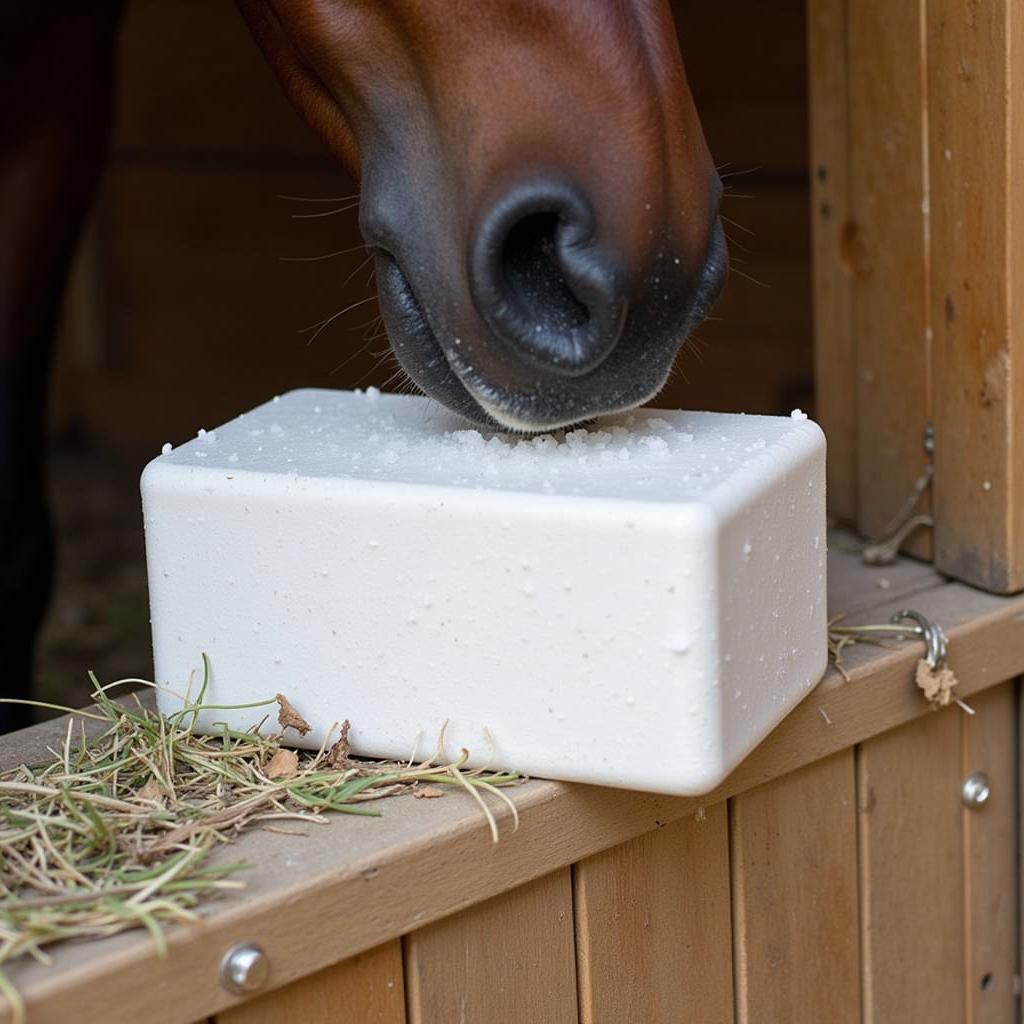Providing your horse with a white salt block is a fundamental aspect of equine care. These blocks offer free-choice access to essential sodium chloride, crucial for maintaining proper hydration and electrolyte balance. But not all salt blocks are created equal. Understanding the benefits, different types, and proper usage of white salt blocks can significantly impact your horse’s health and wellbeing.
The Importance of White Salt Blocks for Equine Health
 Horse licking a white salt block in the pasture
Horse licking a white salt block in the pasture
Horses lose vital electrolytes through sweat, especially during exercise or in hot weather. Sodium, the primary component of white salt blocks, plays a key role in nerve and muscle function, fluid balance, and nutrient absorption. Without sufficient sodium, horses can experience dehydration, muscle weakness, and decreased performance. Offering a salt lick horse ensures they can replenish these lost minerals as needed.
Choosing the Right White Salt Block for Your Horse
There are several types of white salt blocks available, including plain white salt, Himalayan salt, and mineralized salt blocks. Plain white salt blocks provide pure sodium chloride, while Himalayan salt offers additional trace minerals. Mineralized salt blocks are fortified with essential minerals like calcium, phosphorus, and magnesium. Selecting the best mineral block for horses requires considering your horse’s individual needs and diet.
Plain White Salt Blocks: A Simple Solution
These blocks are the most basic and economical option, providing a readily available source of pure sodium chloride. They are a good choice for horses with balanced diets who need a simple salt supplement.
Himalayan Salt Blocks: Added Trace Minerals
Himalayan salt blocks, known for their pink hue, contain trace minerals like iron, potassium, and magnesium, which can further support overall health.
Mineralized Salt Blocks: Comprehensive Mineral Supplementation
 Horse with a mineralized salt block in its stable
Horse with a mineralized salt block in its stable
For horses with mineral deficiencies or those on forage-based diets, mineralized horse salt blocks are a great option. These blocks provide a wider range of essential minerals, ensuring your horse receives a balanced supplement.
How to Use White Salt Blocks Effectively
Providing a white salt block is simple, but there are a few key considerations to ensure your horse gets the most benefit.
- Placement: Place the block in a clean, dry location easily accessible to your horse, such as in the pasture, stall, or feed area.
- Multiple Locations: If you have multiple horses, provide multiple blocks to avoid competition and ensure each horse has adequate access.
- Monitoring Intake: Observe your horse’s salt intake. While free-choice access is generally sufficient, excessive or insufficient consumption can indicate underlying health issues.
What are the benefits of a white salt block?
White salt blocks provide essential sodium and chloride, crucial for hydration, muscle function, and nerve impulses.
Where should I place my horse’s salt block?
Place the block in a clean, dry, accessible location, like a pasture, stall, or feed area. Avoid placing it directly on the ground where it can become contaminated.
Can a horse have too much salt?
While rare, excessive salt intake can lead to health problems. Monitor your salt lick horses and consult a veterinarian if you notice excessive consumption.
Dr. Emily Carter, DVM, Equine Nutritionist, explains, “Offering free-choice access to a white salt block is a simple yet effective way to support your horse’s overall health. It ensures they have the necessary electrolytes to maintain optimal performance and well-being.”
Another expert, John Miller, Certified Equine Trainer, adds, “Salt is particularly crucial for horses in training or those exposed to hot and humid conditions. They lose significant amounts of electrolytes through sweat and need a reliable source of replenishment.” Providing a p block for horses is essential for their well being.
In conclusion, a white salt block is a vital addition to your horse’s care routine. By understanding the different types available and implementing proper usage practices, you can ensure your horse has access to this essential mineral, contributing to their overall health and vitality. Remember to choose the best type of salt block for your horse’s individual needs and consult with your veterinarian if you have any concerns.
FAQ
- What type of salt block is best for my horse? This depends on your horse’s individual dietary needs. Consult with your veterinarian or an equine nutritionist.
- How often should I replace my horse’s salt block? Replace the block when it becomes significantly worn down or contaminated.
- Are Himalayan salt blocks better than plain white salt blocks? Himalayan salt contains trace minerals, which may be beneficial, but plain white salt is sufficient for many horses.
- Can miniature horses use regular salt blocks? Yes, but ensure the block is placed in a way that’s easily accessible for them.
- What should I do if my horse isn’t licking the salt block? Try different locations or types of salt blocks. Consult a veterinarian if the issue persists.
- Can I give my horse loose salt instead of a block? Yes, but offering a block allows for free-choice consumption, ensuring they get the right amount.
- Are there any risks associated with salt blocks? Excessive consumption can be harmful. Monitor your horse’s intake and consult your veterinarian if you have any concerns.
For further assistance, please contact us at Phone Number: 0772127271, Email: [email protected] or visit us at QGM2+WX2, Vị Trung, Vị Thuỷ, Hậu Giang, Việt Nam. We have a 24/7 customer service team.